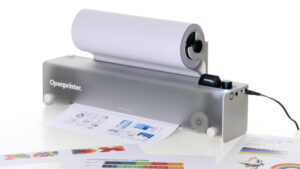At last week’s Consumer Electronics Show in Las Vegas, we again had the opportunity to witness how much the ideas behind open source are changing industries outside of software. I say this because open source hardware was much in evidence at this year’s event.
The press is taking note. In their coverage of CES, Adweek posted an article on an impressive mobile 3D mapping device being made by Occipital.
“All of this is made possible because Occipital is participating in a trend of open source hardware which is changing the way that startups operate. They focus on creating a stable piece of hardware and rely on the development community to extract its full potential for practical application.”

For example, one of the biggest stories at this year’s CES was the abundance of wearable tech products being introduced, with big tech players hyping them as the next big thing. One of the items introduced was Warp, a $149 open source electronics board intended to help developers design wearable products. It’s made by embedded hardware maker Freescale, which with 17 billion semiconductor chips in use globally, is no small player in the hardware world.
Open source hardware has been around for a while, but until recently, the concept has been a tough sell. However, anyone with knowledge of open source software will recognize the underlying philosophy as familiar territory, as pointed out by Christopher Clark at this year’s All Things Open conference.
“There is a lot of overlap between open source software and open source hardware. They’re almost identical. All that meaty stuff in the middle, the big things like free distribution, free redistribution, not limiting based on a specific group of people or a field of endeavor or things like that. That is almost all completely consistent, almost verbatim, in the definitions of each”
Clark is the Director of Information Technology for Boulder, Colorado based SparkFun Electronics, an online retailer of electronic components and gadgets, much of which they design and produce. Both Clark and SparkFun are big proponents of the open source hardware concept. So much so that everything produced in-house is released under an open source license.
Clark noted that in spite of the similarities between open sourcing software and hardware, there are differences. After all, although hardware and software go together like bread and butter, they are very different animals.
“The biggest difference … is that it [hardware] is real. It is a physical thing and that is all the difference in the world. Software is something that can be created over and over again. they’re ones and zeros. We know this. This is why piracy is the way piracy is. But it’s a different game when it comes to hardware, because it’s a real thing and you need to manufacture it. You need atoms to rearrange and that’s a very different thing entirely.”
Open sourcing hardware means supplying the user with enough information so they can recreate the product on their own, which means a whole different way of looking at the “source”.
“The difference for hardware is that you’re not distributing source code; you’re distributing documentation. Documentation is the meat of open source hardware. In order for somebody to reproduce your software they need the source code. In order for somebody to reproduce your hardware, they need extensive documentation as to how that hardware is built.”
Because of this, open sourcing a hardware project usually requires more extra work than with software, where releasing as open source usually requires little more than deciding on what license to use and posting the source code somewhere.
“It’s a little easier, I think, to open source software, because you have your source code anyway. You just put it out there. With hardware, you have to go to the lengths of creating all this additional documentation, which you may have anyway to produce that hardware in house. But to go to the lengths needed to make it viable for somebody else to actually use is a lot of extra work.
“Where software documentation is easily ignored by lots of development teams, my own included, you just can’t do that [with hardware]. You can’t cut corners for open source hardware because it’s just not going to fly. You won’t be able to use it.”
Just as with open source software, there are a variety of open source hardware licensing schemes. For example, there are duel licensing plans which allow the free use of an open source device but which requires a license to redistribute. Some open source hardware vendors take a page from the Red Hat playbook and monetize their product by offering service and support. Then there’s open core, which is just as controversial with hardware as it’s been with software.
When Clark spoke about the open core model, he began by addressing the model as it applies to software.
“Basically you’ve got a core of open source in the middle and everything that is attached to it is proprietary. Now, this really just pisses off the purists, right? Because why do you have this one thing open source and the rest is proprietary? Personally, I don’t think this model is particularly sustainable.
“There are a lot of examples of companies that were doing it this way and espousing it and then they backtracked. Eucalyptus is a prime example of this. An open source platform for building Amazon compatible cloud platforms, they were primarily open core. The last few years, they’ve actually backtracked. They’ve gone with a different model because they heard backlash from the community.
“The biggest example on this is increasingly Android, believe it or not. Now, I love Android. I love my Android phone. But Ars Technica just this week came out with a fantastic article that I highly recommend you check out called Google’s Iron Grip On Android. It really lays out how Google has taken the Android core, ASOP, the Android Open Source Platform, and they’ve really cut it off. A lot of the new stuff, like Play Store, their Maps API and things like that: totally closed source. Totally proprietary.
“Poor old ASOP, the actual Android Open Source Platform that a lot of vendors would like to use and potentially fork, is getting locked out from all the great stuff. So they are definitely moving to an open core model, but they’re doing it very discretely.”
He went on to explain that the open core model has the potential to be just as disruptive in the open source hardware realm as it has been to FOSS.
“You’re going to open source the core of the hardware but you’re going to have these peripherals that connect to it or are a part of the environment that are going to be proprietary and therefore you’re going to make some extra money on that somehow. I don’t see this happening.
“First of all, where’s the line? With dual licensing there’s a very clear division. You have one piece of hardware. It may be slightly divergent under one license or the other, but there’s a clear division there. It’s one or the other. With open core there’s always going to be this debate on where the line is–what’s proprietary, what’s not. Just like software, hardware, especially open hardware, is going to … improve, and so that line is going to keep shifting around. It’s not going to be sustainable. At least, I don’t think it’s going to be sustainable.
“It’s also going to jeopardize community changes This is exactly what we see with the open core model in software. When you have an open core, you’re trying to drive that community innovation through the core. All those peripherals can’t benefit from that same open capability and the community can’t get in there and make their own improvements. So it actually stifles community changes in the long term.”
With FOSS, it’s not uncommon for changes made downstream to be incorporated back upstream. A change made by Ubuntu, for example, might eventually be used in Debian or even the Linux kernel. The same holds true for open source hardware.
Speaking off the top of his head, Clark offered an example of this in response to a question during the Q&A period after his presentation at All Things Open. He described what happened when a company created a knock-off of some open sourced circuitry developed by SparkFun.
“I forget what board it was, but they added a different switch to it. It was a good design change. We just happened to see this was happening with one of our products. We kept an eye on it but we were never even thinking about legal actions, cease and desist or any of that stuff, because it was open source. As soon as they made that change and our engineers looked at it, it was like ‘that was a good idea. Let’s do that too.’ So we did and we gave that attribution back.”
As Adweek pointed out, hardware projects using the open source model were very much in evidence at this year’s CES. Interoperability was key, with several teams showing their products working with technology from other projects. The descriptions show promise.
“In one prototype, Occipital maps the environment while 3Gear maps the hands of the user as they pass through the user’s field of vision. This information is then passed back through the Oculus in stereoscopic 3D where it is rendered onto the display within the Oculus headset. Eventually, the ability to see our own bodies interacting with a real environment, all rendered in 3D in real time, has fascinating implications for the gaming industry and beyond.”
If I were a betting person, I would wager that open source hardware will get the traction it needs to become a growing force in the hardware marketplace. I expect that at next year’s CES we’ll see even more notice being given to open source hardware projects. It’s probably also inevitable that we’ll also see strong partnerships between open source hardware and software vendors. That too would be a move in the right direction, I think.
Christine Hall has been a journalist since 1971. In 2001, she began writing a weekly consumer computer column and started covering Linux and FOSS in 2002 after making the switch to GNU/Linux. Follow her on Twitter: @BrideOfLinux







